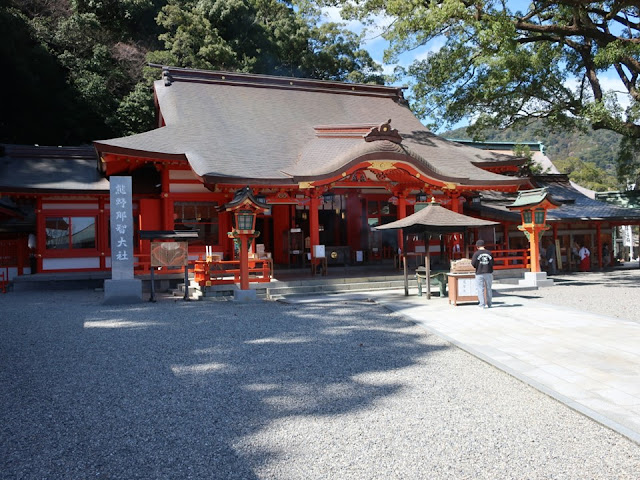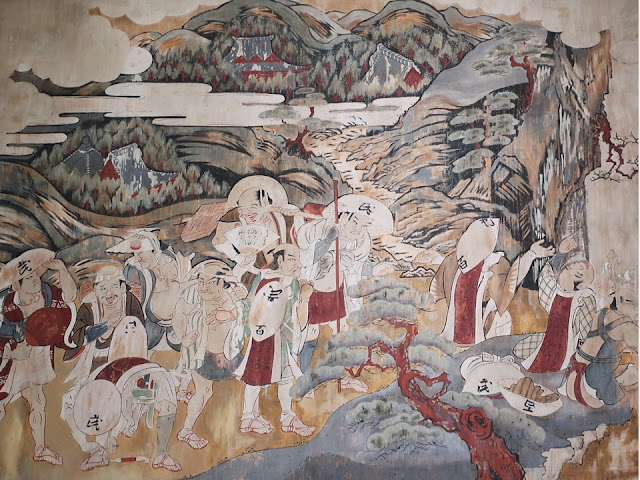Kumano Nachi Taisha (shrine) is one of three
grand shrines of Kumano in Wakayama Prefecture of western Japan. Pepple
across Japan have visited Kumano since more than a thousand years ago.
Emperors also visited; the 77th emperor Goshirakawa (1127-1192)
visited thirty-four times for example. Old roads to Kumano still remain, which
are designated as UNESCO World Heritage Site along with three grand shrines.
I visited Matsumoto Pass on the old
road (below), then visited Kumano Nachi Taisha. While seeing solemn scenery, I
felt the mindset of pilgrims in the old days.
南紀には、熊野三山(熊野本宮大社、熊野那智大社、熊野速玉大社)と呼ばれる神社があります。熊野信仰で千年以上前から多くの人々が参詣に訪れました。後白河法皇は34度、孫の後鳥羽上皇は31度も訪れたのですよ。古い道が各地に残っていて、熊野古道として三山と共に世界遺産になっています。
熊野古道にあった松本峠(上の写真)、那智の滝のすぐ近くにある熊野那智大社を訪ねました。旅を楽しんだだけともいえますが、厳かな風景を見ると、何かを求めて参詣に向かう人々の気持ちが分かります。
Matsumoto Pass、松本峠
There are Buddhist statues at the pass (129m above sea level). It’s a good hiking course, and it takes around one hour.
松本峠(129m)は熊野市にあり、残っている古道は、小一時間の手軽なハイキングコースです。
After getting over the pass, we can see the Pacific Ocean and Shichiri (28km) – mihama (beach). The road leads to the ground shrines. It was a major route from Ise shrine to Kumano shrines in the Edo period (1603~1868); Ise has been a popular pilgrimage destination and a sightseeing spot.
峠を過ぎると七里御浜が見え、道は熊野三山へと向かっていきます。江戸時代は、お伊勢参りの後に、熊野に向かうのがメジャーなルートでした。
Kumano Nachi Taisha、熊野那智大社
Nachi is around 320km away from Kyoto which was the capital from 794 to 1869. The slope above (Daimon-zaka) is just before Kumano Nachi Taisha.
那智山は京の都から八十里、往復一ヶ月の行程でした。那智大社に続くほぼ最後の石段、大門坂です。
The steps are the last slope to the shrine. The guideline for visitors (left) is written in the dialect: it says “Please bring back everything that you brought here” and so on. It makes the guideline soft.
神社の参道。最後の坂です。入山心得を方言で書いた商店会の看板(左)が気持ちを癒やしてくれます。
Main hall. The deity who was enshrined descended here and went to Nara, then became the first emperor Jinmu. The deity’s name is Kamu-yamato-iwarebiko-no-mikoto.
本殿です。神倭磐余命はこの地に上陸され、大和に行き、神武天皇になったとされています。
It is written in the ancient Japanese chronicles that Yatagarasu (lower left, three-legged crow) guided the first emperor to Nara. The Yatagarasu returned here, transformed to the stone and have rested.
神武天皇を奈良へ案内したのが八咫烏です。その後、熊野に戻り、石に姿を変えここ御縣彦社(みあがたひこしゃ)で休んでいます。
It is the view from the torii gate. White dots at the side of the opposite mountains were sakura (cherry blossoms) which started blooming.
鳥居からの眺めです。向こうの山にある点々とした白いものは咲き始めた桜です。
Not only emperors but also many ordinary people have visited here.
この境内には、天皇だけでなく多くの人々が訪れました。
There is Seigantoji (temple) behind the gate. It is the 1st temple on thirty-three temple pilgrimage route of western Japan. It had been a part of Kumano Nachi Taisha, however, it was separated in the Meiji period (1868-1912) due to the edicts ordering the separation of Shinto and Buddhism.
門をくぐると青岸渡寺があります。西国三十三ヵ所巡礼の一番札所です。神仏分離で寺院として独立しました。
It says, “This fish memorial was erected in 1964 for the repose of the souls of all marine organisms, including whales. This memorial embodies the ethos and culture of local people who console the souls of marine organisms to express gratitude to the animals for providing humans with the foundations for lives.” There are many memorials not for human in Japan.
境内には魚霊供養碑があります。「鯨をはじめすべての魚介の冥福を祈る供養碑として昭和39年に建立された。様々な魚の命をいただくことに対する感謝の表れとして、供養するという精神文化がここにある」と書かれています。日本には生き物や物(筆など)の供養碑が多いのです。
We can see the famous Nachi Waterfall (lower left) from the ground.
境内からは、那智の滝(左下)が見えます。
The view of the falls and the three-storied pagoda is very popular; it is what I wanted to see. Let’s go to the falls.
滝と三重塔、定番の撮影スポット、私が見たかった景色です。では、滝へ向かいましょう。
I went down the stone steps to the waterfall in the tall Japanese cedars.
滝へと下ってきた石段の道。立派な杉の間を抜けて来ました。
Nachi Waterfall (drop 133 m) is the deity dwelling object of Hiro shrine. I couldn’t take the picture horizontally.
落差133mの那智の滝は飛龍神社の御神体です。縦長でないと入りません。
There is a sacred rope above the waterfall. It means the deity is behind the rope. I felt the divine atmosphere.
滝上には注連縄があります。神様がいらっしゃるところですね。ありがたさを感じます。
We can see the waterfall from the prayer place above. Many people including a retired emperor have done a waterfall training.
奥から御神体である滝が見える御瀧本祈願所では、花山法皇をはじめ多くの人が滝行を務めました。文覚上人、安倍晴明の名も記されています。
The picture above of the wooden board was drawn in 1815 after people in eastern Japan visiting the shrine, and it was offered to their local shrine. The waterfall (left) impressed them, I’m sure. It is the exhibit (replica) of Miyashiro museum.
1815年に熊野詣を無事に終えた埼玉県の一行が、記念として地元の神社に奉納された絵馬です。この滝(右側)は誰の心にも強く残ったと思います。宮代町郷土資料館の展示品(複製)です。
Although I visited on Wednesday, there were many visitors especially foreigners.
It was so a grateful day for me because I
felt deities and Buddha protect us.
水曜日でしたが滝には多くの人が訪れていました。熊野三山では、外国人が目立ちます。
心が洗われ、神仏が我々を守ってくれるというありがたさを感じた一日でした。
Official
website: https://kumanonachitaisha.or.jp/
(in Japanese), accessed in October, 2023
Visited in
March, 2023
Previous post (museum in the same prefecture): Shingu
history and folklore museum、新宮市立歴史民俗資料館
Next post (rare and famous hot-spring in the same town):Boki-do cave bath (Hotel Urashima)、忘帰洞(ホテル浦島)

















Comments
Post a Comment